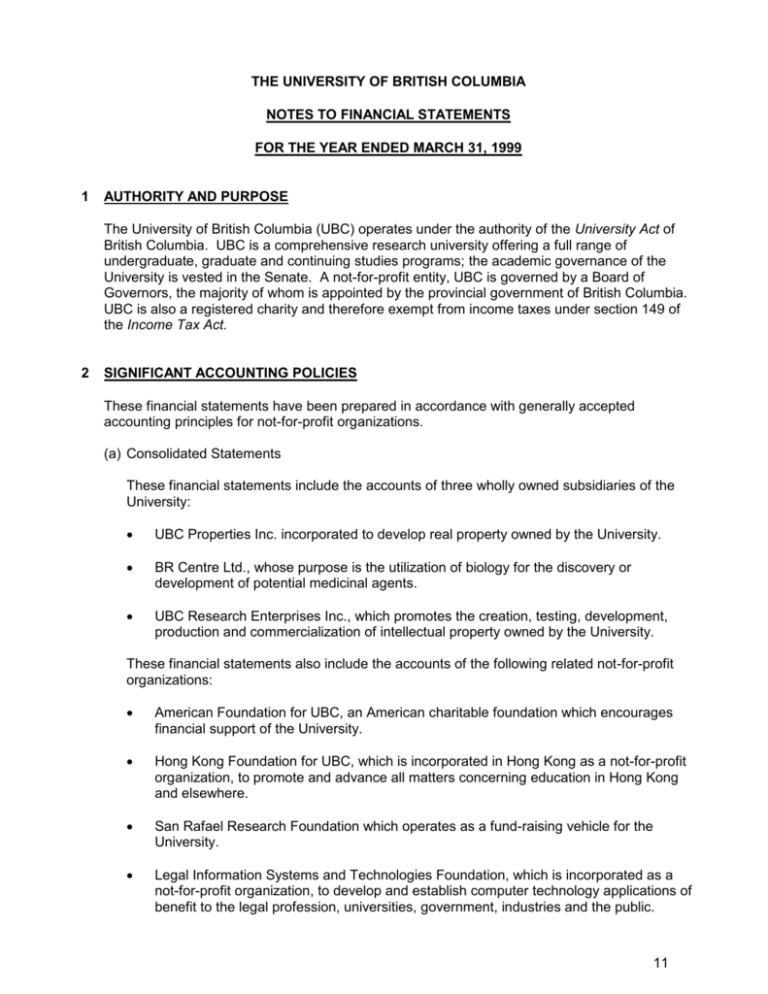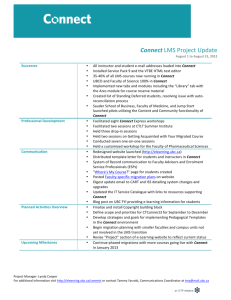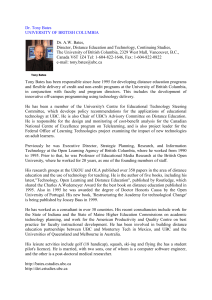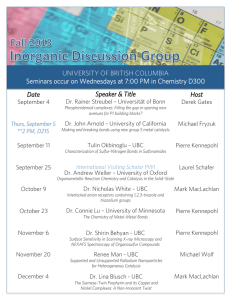notes to financial statements - University of British Columbia
advertisement

THE UNIVERSITY OF BRITISH COLUMBIA NOTES TO FINANCIAL STATEMENTS FOR THE YEAR ENDED MARCH 31, 1999 1 AUTHORITY AND PURPOSE The University of British Columbia (UBC) operates under the authority of the University Act of British Columbia. UBC is a comprehensive research university offering a full range of undergraduate, graduate and continuing studies programs; the academic governance of the University is vested in the Senate. A not-for-profit entity, UBC is governed by a Board of Governors, the majority of whom is appointed by the provincial government of British Columbia. UBC is also a registered charity and therefore exempt from income taxes under section 149 of the Income Tax Act. 2 SIGNIFICANT ACCOUNTING POLICIES These financial statements have been prepared in accordance with generally accepted accounting principles for not-for-profit organizations. (a) Consolidated Statements These financial statements include the accounts of three wholly owned subsidiaries of the University: UBC Properties Inc. incorporated to develop real property owned by the University. BR Centre Ltd., whose purpose is the utilization of biology for the discovery or development of potential medicinal agents. UBC Research Enterprises Inc., which promotes the creation, testing, development, production and commercialization of intellectual property owned by the University. These financial statements also include the accounts of the following related not-for-profit organizations: American Foundation for UBC, an American charitable foundation which encourages financial support of the University. Hong Kong Foundation for UBC, which is incorporated in Hong Kong as a not-for-profit organization, to promote and advance all matters concerning education in Hong Kong and elsewhere. San Rafael Research Foundation which operates as a fund-raising vehicle for the University. Legal Information Systems and Technologies Foundation, which is incorporated as a not-for-profit organization, to develop and establish computer technology applications of benefit to the legal profession, universities, government, industries and the public. 11 UBC Society for Young Children which maintains and operates an educational program for young children. These financial statements do not include the assets, liabilities and results of operations for entities and organizations in which UBC holds an equity interest but does not exercise control. These organizations include the UBC Foundation, which was formed to develop public awareness and encourage financial support for the University (see Note 15a). (b) Revenue Recognition i) Restricted Revenues Some contributions, such as grants and donations for research or capital purposes, are restricted in use by the external contributor. These restricted contributions are considered “unearned” and are deferred until the related expense is incurred. In the case of revenues received for the purchase of capital assets having a limited life, an amount equivalent to the depreciation expense is reported as revenue each year. Note 7 provides a summary of changes in unearned revenues over the course of the year. Some restricted contributions must be retained in perpetuity and only the investment income expended. These contributions are recorded as an increase in endowment equity. Investment income earned on these restricted endowments is recognized when the related expenditure occurs. ii) Unrestricted Revenues Revenues received without restrictions include the operating grant from the Province of British Columbia, tuition fees and sales of services and products. Monies received from these sources are reported as revenue at the time the product is delivered or the services are substantially provided. (c) Investments Investments are recorded at cost or, where donated, at fair market value on the date of donation. Investment value is written down when there has been a significant and permanent impairment in value. (d) Inventory Inventories of merchandise held for resale are recorded at the lower of cost and net realizable value. Supplies inventories are recorded at cost. (e) Capital Assets Capital asset acquisitions are recorded on the balance sheet at cost, except donated assets, which are recorded at market value at the date of acquisition. Land granted to the University is recorded at nominal value. Funds invested in hospitals represents capital additions to hospitals funded by the Province of BC through the University. The University has no legal ownership of these buildings. Library books and periodicals are recorded at cost. Collections are recorded at a nominal value. 12 The following assets are depreciated on a straight-line basis over their estimated useful life. Site improvements Buildings Building renovations Furnishings, equipment and systems Library books Funds invested in hospitals 25-80 years 10-50 years 5-10 years 3-10 years 10 years 40 years (f) Gifts-in-Kind Gifts-in-kind include securities, furnishings and equipment, books and manuscripts and artwork and artifacts. For the fiscal year 1998/99, gifts-in-kind with a market value of $25.7 million were received (1998 - $5.4 million), of which $3.6 million (1998 - $300,000) of artwork and artifacts is not recorded in the financial statements. (g) Contributed Services The University acknowledges the substantial services provided by volunteers in assisting the institution in carrying out its activities. Due to the difficulty in determining their value, these services are not reported in the financial statements. (h) Financial Instruments i) Current assets The fair value of cash and short term investments, accounts receivable, accounts payable and accruals approximate their carrying values because of the short term maturity of these instruments. ii) Investments Market risk on the University’s investments is mitigated through diversification of investments by asset class and issuer. iii) Long Term Debt Borrowings are denominated in Canadian dollars only and are at fixed rates of interest. 13 3 CHANGES IN ACCOUNTING POLICY AND PRIOR PERIOD ADJUSTMENTS During the year, the University changed its capital asset capitalization and depreciation policies in order to more accurately reflect these assets and expenses in the accounts. a) Capital infrastructure costs are depreciated over their estimated useful life. Previously, costs such as repairs and replacements of existing infrastructure were expensed. Funding received for these assets are added to deferred capital contributions and amortized over the assets’ estimated useful life. Previously, they were taken into income and added to Equity in capital assets. This change has the effect of increasing revenue over expenses for the year by $833,000 (1998 $1.1 million) and decreasing equity in capital assets by $34.7 million (1998 $33.9 million). b) Capital asset values have been adjusted and depreciation policies have been modified to more accurately reflect the cost and depreciation of University assets. This change has the effect of decreasing revenues over expenses by $806,000 (1998 $1.1 million) and decreasing equity by $1.5 million (1998 $2.3 million). These changes have been applied retroactively. 4 CAPITAL ASSETS Cost 1999 Less Accumulated Depreciation 1998 Net Book Value Net Book Value (thousands of dollars) Land and site improvements 49,503 $ 28,116 827,063 235,793 591,270 580,743 and systems 155,970 62,883 93,087 96,434 Library books 94,403 37,436 56,967 54,043 Funds invested in hospitals 20,623 6,702 13,921 14,436 $ 1,147,562 $ 370,930 $ 776,632 $ 765,803 Buildings and renovations $ $ 21,387 $ 20,147 Furnishings, equipment, Total capital assets 5 LONG TERM EMPLOYEE BENEFITS & PENSION PLANS Long term employee benefit liabilities consist of a long-term disability plan and a supplemental arrangement for excess pension contributions. The most recent comparison of the Long Term Disability Plan between the commitment as determined by the University's actuaries and the plan assets on hand was made at March 31, 1998. At that date the assets exceeded commitments by $2.8 million (March 31, 1997 – commitments exceeded assets by $953,000). The elimination of the shortfall and creation of the surplus results from return-to-work initiatives and better than expected investment returns. 14 The University has two pension plans which are administered by separate trustees/directors. The Faculty Pension Plan is a defined contribution plan, which provides benefits on a money purchase basis. The University contribution for this plan is 10% less a fixed offsetting amount relating to Canada Pension Plan contributory earnings. The Staff Pension Plan provides benefits based on 2% of the average best three years' basic salary multiplied by the number of years of contributory service, less an adjustment for Canada Pension Plan contributory earnings. The University contribution for the Staff Pension Plan is limited to 10% of salary, less a fixed offsetting amount relating to Canada Pension Plan contributory earnings. The latest actuarial valuation of the Staff Pension Plan at January 1, 1996 showed a surplus of plan assets over liabilities of $23.2 million. The University expenses plan contributions in the year in which they are made. 6 LONG TERM DEBT Debt funded by the Province of BC British Columbia Educational Institutions Capital Financing Authority Debenture Sinking funds Unamortized discounts Maturity Date Interest Rate 1999 to 2024 5.4% to 17.51% Net outstanding Certificates of approval Total payable by the Province of BC Debt funded by the University Canada Mortgage and Housing Corporation mortgages Province of BC Debenture Sinking funds Unamortized discounts Net outstanding Other Total payable by the University Total Long Term Debt - - 2012 to 2023 5.125% to 7.875% 2006 to 2013 8.5% to 10.04% Amount Outstanding 1999 1998 (thousands of dollars) $ - $ 398,534 (114,975) (303) - 283,256 - 18,844 302,100 16,629 17,030 61,700 (18,859) (583) 61,700 (15,532) (622) 42,258 45,546 10,868 69, 755 13,124 75,700 $ 69,755 $ 377,800 As of the financial statement date, the fair market value of long term debt funded by the University was $87.2 million (1998 $90.9 million). Pursuant to the Capital Financing Authority Repeal and Debt Restructuring Act, (S.B.C. 1998, c.6) the debt obligations to the British Columbia Educational Institutions Capital Financing Authority, together with the associated sinking funds, were assumed by the government of British Columbia, effective April 1, 1998. As of April 1, 1998 the University is deemed to have received contributions of $302.1 million. These contributions are now shown as deferred capital contributions and amortized at the same rate as the associated capital assets. 15 Requirements to meet the principal portion of long-term debt repayments over the next five years are as follows: Debt funded by the University (thousands of dollars) 2000 2001 2002 2003 2004 7 $ 4,233 4,411 4,576 4,751 1,892 DEFERRED CONTRIBUTIONS Capital contributions received to purchase capital assets are deferred and recognized as revenue when related assets are depreciated. Deferred Sponsored Research, Specific Purpose and Other contributions represent grant, contract and donation revenue which has a designated purpose. They are considered “unearned” until the related expense occurs. Capital Sponsored Research Specific Purpose 1999 Total 1998 Total $ 1,512 $ 259,643 $ 253,495 5,805 27,474 18,389 Other (thousands of dollars) Balance, beginning of year, as previously reported Retroactive adjustments Balance, beginning of year Grants, contributions, & donations received Deemed capital contributions (Note 6) Transferred to revenue Balance, end of year 8 $ 150,908 $ 53,679 $ 53,544 17,752 3,917 $ 168,660 $ 57,596 $ 53,544 $ 7,317 $ 287,117 $ 271,884 26,188 140,461 59,738 28,030 254,417 295,187 302,100 - - - 302,100 - (29,602) (238,257) (279,954) 5,745 $ 605,377 $ 287,117 (16,503) (134,032) (58,120) $ 480,445 $ 64,025 $ 55,162 $ GRANTS TO OTHER AGENCIES During the year the University distributed research and other funds to other agencies totalling $10.3 million (1998 - $10.1 million). These funds were distributed under agreements with granting agencies, whereby the University is the administrative head and a portion of the research is undertaken at other agencies. 9 EQUITY The University classifies equity into the following categories: 16 a) Operating equity is unrestricted as to use. b) Reserves represent amounts set aside by the University for specific uses, such as employee benefit programs and vacation pay, as well as operational surpluses accumulated by continuing studies, ancillary, and fee for service operations. c) Equity in capital assets represents the portion of capital assets funded by the University, net of outstanding debt. It excludes those assets funded through capital contributions. d) Endowment principal is described in Note 11. e) Equity in related organizations results from the consolidation of those entities outlined in Note 2(a). Operating Equity in Capital Assets Reserves Endowment Related Principal Organizations 1999 Total 1998 Total 26,002 - $ 637,406 (36,195) $ 578,449 (30,998) (Note 10) (thousands of dollars) Balance, beginning of year, as previously reported Retroactive adjustments Restated balance, beginning of year Excess of revenues over expenses Transfer to UBC Foundation Endowment donations Balance, end of year $ (4,460) - $ 18,448 (340) (4,460) 18,108 121 $ (4,339) $ (5,097) $ 13,011 $ 202,522 (35,855) $ 394,894 - $ 166,667 394,894 26,002 601,211 547,451 7,780 - 9,079 37,050 (917) (17,000) - 10,966 (17,000) 37,050 30,712 23,048 174,447 $ 441,023 8,085 $ 632,227 $ 601,211 $ 10 EQUITY IN CAPITAL ASSETS Equity in Capital Assets is made up of the following: 1999 1998 (thousands of dollars) Total capital assets (Note 4) Long term debt (note 6) Deferred capital contributions (Note 7) Funded from cash reserves Equity in capital assets $776,632 $ 765,803 (69,755) (377,800) (480,445) (168,660) (51,985) (52,676) $ 174,447 $ 166,667 17 11 ENDOWMENT PRINCIPAL Endowment principal consists of restricted donations to the University and internal allocations by the University, the original principal of which must be maintained in perpetuity. The University has established the following endowment management policy: to balance present spending needs with expected future requirements, to protect the purchasing power of the capital base of endowments while achieving stability in year-to-year spending, and to attain real increases in purchasing power through capital appreciation from new gifts, capital investment gains and the capitalization of income. The book value of all endowments is as follows: 1999 1998 (thousands of dollars) Balance, beginning of fiscal year $ 394,894 $ 350,689 37,050 23,048 9,079 21,157 441,023 394,894 14,718 12,178 4,656 - Endowment at UBC Foundation 18,958 19,645 Endowment at Vancouver Foundation 15,514 15,456 $ 494,869 $ 442,173 Donations Capitalized income and other transfers Balance, end of fiscal year (Note 9) Endowment at Advanced Wood Products Funding Society Endowment at Advanced Papermaking Institute Total of all endowments The Advanced Wood Products Funding Society, the Advanced Papermaking Institute, UBC Foundation and Vancouver Foundation endowments reported above are not recorded on the University’s books as they are not owned by the University. Income from these endowments is earned exclusively for the benefit of the University. The market value of all endowments is as follows: 1999 1998 (thousands of dollars) Endowments recorded in the financial statements Endowments held at other organizations Total market value, all endowments $ 508,641 $ 490,553 63,605 60,839 $ 572,246 $ 551,392 18 12 YEAR 2000 ISSUES The Year 2000 issue arises because some date sensitive computer systems use two digits rather than four to identify a year and therefore may not correctly recognize the Year 2000. As a result, if all related system problems are not fully identified, the impact on operations and financial reporting could range from minor errors to system failures and could occur before, on or after January 1, 2000. In addressing the Year 2000 issue, the University has invested significant resources, including upgrading its major financial and student systems. The University is confident that Year 2000 issues will not adversely affect its operations. 13 COMMITMENTS AND CONTINGENT LIABILITIES At March 31, 1999 outstanding commitments totalled $5.7 million (1998 - $10.5 million) for capital projects. These commitments are payable in subsequent years, and are funded by provincial contributions, private donations and earnings from sales and services. The University is involved from time to time in litigation, which arises in the normal course of operations. Liabilities on any litigation are recognized in the financial statements when the outcome becomes reasonably determinable. In the administration’s judgment, no material exposure exists at this time on the eventual settlement of any existing litigation. 14 DONATION PLEDGES The estimated value of donations, which have been pledged but not received as at March 31, 1999, was approximately $34.9 million. These amounts are not reflected in the financial statements of the University. In October 1998, the University received a covenant of gift from Dr. S. Blusson of $50.0 million to support research infrastructure and academic excellence. This gift is held in escrow and has not been reflected in the financial statements. 15 RELATED ORGANIZATIONS (a) University of British Columbia Foundation The UBC Foundation was established to develop public awareness and encourage financial support of the University. During the year, the University received $22.8 million (1998 - $6.4 million) from the Foundation which was recorded as bequest and donation revenue. At March 31, 1999, the Foundation held $19.0 million (1998 - $19.6 million) in endowments for the benefit of the University. 19 (b) Tri-Universities Meson Facility (TRIUMF) The University is one of four parties to a joint venture agreement under which research is conducted at the Tri-Universities Meson Facility on the UBC campus and elsewhere. During the year, TRIUMF purchased services and supplies from the University during the normal course of business. The total value of these transactions for the year was $24.9 million (1998 - $22.1 million). (c) Western Canadian Universities Marine Biological Station (WCUMBS) The University is one of five university members of the Western Canadian Universities Marine Biological Station (WCUMBS). The University’s annual operating grant to the Society was $160,000 (1998 - $150,000) and is recorded as an expenditure of the University. The accounts of WCUMBS are not included in these statements. There is no expectation of monetary gain to the University from this venture. 16 UNIVERSITY TECHNOLOGY TRANSFER The University holds equity positions in 33 companies (1998 – 31 companies) formed from the commercialization of University research. The value of these holdings is $8.1 million (1998 $8.2 million). These amounts are not reflected in the financial statements of the University. 17 COMPARATIVES Certain comparative figures have been restated to conform with the current year's presentation. 20




![July 31 Connect eupdate DRAFT [1]](http://s3.studylib.net/store/data/008100166_1-21bd0e395dcbfd67aaad5f18dd4ec08e-300x300.png)


